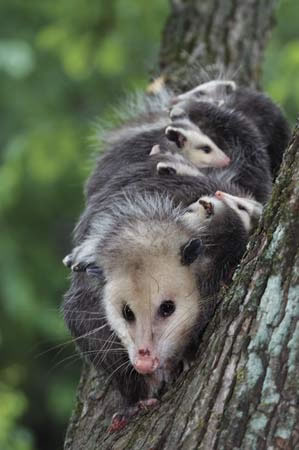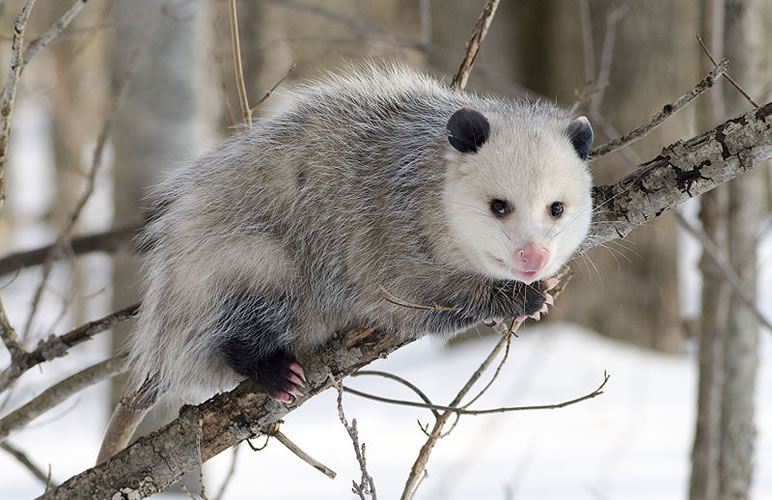 |
Canku Ota
|
 |
|
(Many Paths)
|
||
|
An Online Newsletter
Celebrating Native America
|
||
|
February 1, 2010 - Volume
8 Number 2
|
||
|
|
||
|
Virginia Opossum
- Didelphis virginiana
|
||
|
Characteristics
The opossum has opposable hallux. A hallux is like a thumb. The opossum's "thumbs" are on its rear feet. The hallux helps it grasp branches when it climbs. The opossum doesn't hibernate in the winter. It will often hole up during very cold weather because it runs the risk of getting frostbite on its hairless ears, tail and toes.
Range
Habitat Diet
The babies climb up the mother's fur and into her pouch where they find a teat. Some babies will not find their way to the pouch and will die. If they make it to the pouch, only babies who find one of the thirteen teats will survive. They will stay in the pouch and suckle for 55-60 days. Then they will move out of the pouch and spend another four to six weeks on their mother's back. In some parts of their range, females will have three litters a year.
Behavior The name 'opossum' was first used in western culture by Captain John Smith in 1608. It comes from the Algonquin name 'apasum', which means 'white animal.'
|
|
|
||
|
|
||
| Canku Ota is a free Newsletter celebrating Native America, its traditions and accomplishments . We do not provide subscriber or visitor names to anyone. Some articles presented in Canku Ota may contain copyright material. We have received appropriate permissions for republishing any articles. Material appearing here is distributed without profit or monetary gain to those who have expressed an interest. This is in accordance with Title 17 U.S.C. Section 107. | ||
|
Canku Ota is a copyright ©
2000, 2001, 2002, 2003, 2004, 2005, 2006, 2007, 2008, 2009, 2010
of Vicki Barry and Paul Barry.
|
||
 |
 |
|
|
The "Canku
Ota - A Newsletter Celebrating Native America" web site and
its design is the
|
||
|
Copyright ©
1999, 2000, 2001, 2002, 2003, 2004, 2005,
2006, 2007, 2008, 2009, 2010
of Paul C. Barry.
|
||
|
All Rights Reserved.
|
||
 The
opossum is about the size of a large house cat. It has a triangular
head and a long pointed nose. It has grayish fur everywhere but
on its ears, feet and tail. Its tail is prehensile. A prehensile
tail is adapted for grasping and wrapping around things like tree
limbs. The opossum can hang from its tail for a short time. Some
people think opossums hang from their tails and sleep. They don't.
Their tails aren't strong enough to hold them for that long!
The
opossum is about the size of a large house cat. It has a triangular
head and a long pointed nose. It has grayish fur everywhere but
on its ears, feet and tail. Its tail is prehensile. A prehensile
tail is adapted for grasping and wrapping around things like tree
limbs. The opossum can hang from its tail for a short time. Some
people think opossums hang from their tails and sleep. They don't.
Their tails aren't strong enough to hold them for that long!  Life
Cycle
Life
Cycle